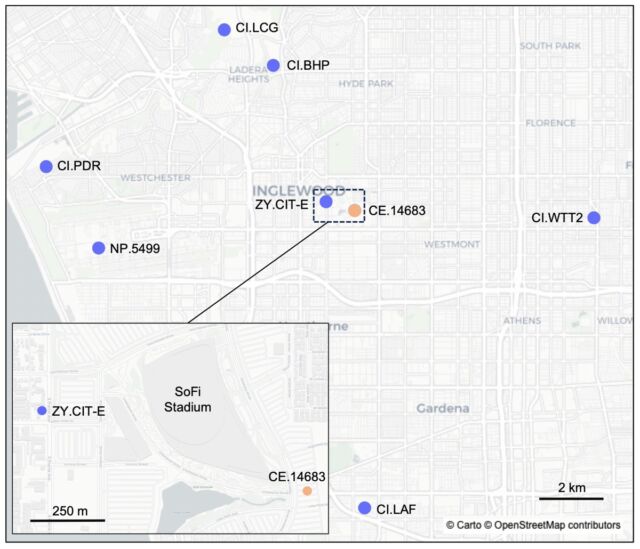
When mega pop star Taylor Swift gave a series of concerts last August at the SoFi Stadium in Los Angeles, regional seismic network stations recorded unique harmonic vibrations known as "concert tremor." A similar "Swift quake" had occurred the month before in Seattle, prompting scientists from the California Institute of Technology and UCLA to take a closer look at seismic data collected during Swift's LA concert.
The researchers concluded that the vibrations were largely generated by crowd motion as "Swifties" jumped and danced enthusiastically to the music and described their findings in a new paper published in the journal Seismological Research Letters. The authors contend that gaining a better understanding of atypical seismic signals like those generated by the Swift concert could improve the analysis of seismic signals in the future, as well as bolster emerging applications like using signals from train noise for seismic interferometry.
Concert tremor consists of low-frequency signals of extended duration with harmonic frequency peaks between 1 and 10 Hz, similar to the signals generated by volcanoes or trains. There has been considerable debate about the source of these low-frequency concert tremor signals: Are they produced by the synchronized movement of the crowd, or by the sound systems or instruments coupled to the stage? Several prior studies of stadium concerts have argued for the former hypothesis, while a 2015 study found that a chanting crowd at a football game produced similar harmonic seismic tremors. However, a 2008 study concluded that such signals generated during an outdoor electronic dance music festival came from the sound system vibrating to the musical beat.
AdvertisementThe Caltech/UCLA team didn't just rely on the data from the regional network stations. The scientists placed additional motion sensors throughout the stadium prior to the concert, enabling them to characterize all the seismic signals produced during the concert. The signals had such unique characteristics that it was relatively easy to identify them with a spectrogram. In fact, the authors were able to identify 43 of the 45 songs Swift performed based on the distinctive signal of each song.
They also calculated how much radiated energy was produced by each song. "Shake It Off" produced the most radiated energy, equivalent to a local magnitude earthquake of 0.851. “Keep in mind this energy was released over a few minutes compared to a second for an earthquake of that size," said co-author Gabrielle Tepp of Caltech.
Tepp is a volcanologist and musician in her own right. That combination came in handy when it was time to conduct a lab-based experiment to test the team's source hypothesis using a portable public announcement speaker system. They played Swift's "Love Story" and Tepp gamely danced and jumped with the beat during the last chorus while sensors recorded the seismic vibrations. “Even though I was not great at staying in the same place—I ended up jumping around in a small circle, like at a concert—I was surprised at how clear the signal came out,” said Tepp. They also tested a steady beat as Tepp played her bass guitar in order to isolate the signal from a single instrument.
The resulting fundamental harmonic during the jumping was consistent with the song's beat rate. However, the bass beats didn't produce a harmonic signal, which was surprising since those beats were better synchronized with the actual musical beats than Tepp's jumping motions. This might be due to the rounder shape of the bass beat signals compared to sharper spiking signals in response to the jumping.
Advertisement
The authors noted that their experiment did not involve a stage or stadium-grade sound system, "so we cannot completely rule out loudspeakers as a vibrational energy source," they wrote. Nonetheless, "Overall the evidence suggests that crowd movement is the primary source of the low-frequency signals, with the speaker system or instruments potentially contributing via stage of building vibrations." The fact that the same kind of low-frequency seismic signals were not detected during pre-concert sound checks seems to support that conclusion, although there were higher frequency signals during sound checks.
The team also studied the structural response of the stadium and conducted a similar analysis of seismic readings from three other concerts at SoFi Stadium that summer: country music's Morgan Waller, Beyoncé, and Metallica, as well as picking up clear signals at one monitoring station for the three opening acts: Pantera, DJ Khaled, and Five Finger Death Punch, respectively. The results were markedly similar to the seismic data gathered from the Taylor Swift concerts, although none of the signals matched the strongest of those detected during the Swift concerts.
The researchers were surprised to find that the seismic signals from the Metallica concert were the weakest among all the concerts and markedly different from the others, "slanted and kind of weird looking," per Tepp. They found several comments in music forums from fans complaining about poor sound quality at the Metallica concert. "If fans had a hard time discerning the song or beat, it may explain the more variable signals because it would have influenced their movements," the authors wrote.
It's also possible that heavy metal live performances are less tightly choreographed than Beyoncé or Swift performances, or that heavy metal fans don't move with the music in quite the same way. “Metal fans like to headbang a lot, so they’re not necessarily bouncing,” said Tepp. “It might just be that the ways in which they move don’t create as strong of a signal.”
Seismological Research Letters, 2024. DOI: 10.1785/0220230385 (About DOIs).



















